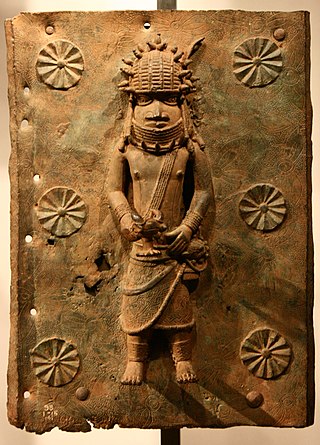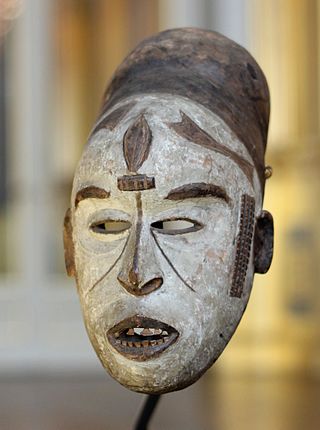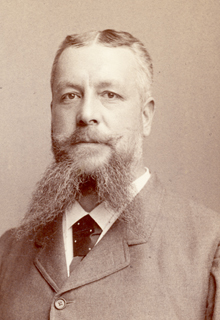Related Research Articles

The Benin Bronzes are a group of several thousand metal plaques and sculptures that decorated the royal palace of the Kingdom of Benin, in what is now Edo State, Nigeria. Collectively, the objects form the best examples of Benin art and were created from the thirteenth century by artists of the Edo people. The plaques, which in the Edo language are called Ama, depict scenes or represent themes in the history of the Kingdom. Apart from the plaques, other sculptures in brass or bronze include portrait heads, jewelry, and smaller pieces.
The International Council of Museums (ICOM) is a non-governmental organisation dedicated to museums, maintaining formal relations with UNESCO and having a consultative status with the United Nations Economic and Social Council. Founded in 1946, ICOM also partners with entities such as the World Intellectual Property Organization, Interpol, and the World Customs Organization in order to carry out its international public service missions, which include fighting illicit traffic in cultural goods and promoting risk management and emergency preparedness to protect world cultural heritage in the event of natural or man-made disasters. Members of the ICOM get the ICOM membership card, which provides free entry, or entry at a reduced rate, to many museums all over the world.

Nazi plunder was the stealing of art and other items which occurred as a result of the organized looting of European countries during the time of the Nazi Party in Germany.

Repatriation is the return of the cultural property, often referring to ancient or looted art, to their country of origin or former owners.

The Musée du Quai Branly – Jacques Chirac, located in Paris, France, is a museum designed by French architect Jean Nouvel to feature the indigenous art and cultures of Africa, Asia, Oceania, and the Americas. The museum collection comprises more than a million objects, of which 3,500 are on display at any given time, in both permanent and temporary thematic exhibits. A selection of objects from the museum is also displayed in the Pavillon des Sessions of the Louvre.

The Universalmuseum Joanneum is a multidisciplinary museum with buildings in several locations in the province of Styria, Austria. It has galleries and collections in many subject areas including archaeology, geology, paleontology, mineralogy, botany, zoology, history, art and folk culture. It is the oldest museum in Austria as well as the largest universal museum in central Europe with over 4.5 million objects in 13 departments and 12 locations in the Styrian cities of Graz, Stainz, Trautenfels, and Wagna. To reflect this status and its growth over the last two centuries, as well as to present a more recognizable image internationally, the Landesmuseum Joanneum was officially renamed to Universalmuseum Joanneum on 10 September 2009.

The Museum of World Cultures is an ethnological museum in Frankfurt, Germany. Until 2001 it was called the Museum of Ethnology.

The Royal Palaces of Abomey are 12 palaces spread over an area of 40 hectares at the heart of the Abomey town in Benin, formerly the capital of the West African Kingdom of Dahomey. The Kingdom was founded in 1625 by the Fon people who developed it into a powerful military and commercial empire, which dominated trade with European slave traders on the Slave Coast until the late 19th century, to whom they sold their prisoners of war. At its peak the palaces could accommodate up to 8000 people. The King's palace included a two-story building known as the "cowrie house" or akuehue. Under the twelve kings who succeeded from 1625 to 1900, the kingdom established itself as one of the most powerful of the western coast of Africa.

Some African objects had been collected by Europeans for centuries, and there had been industries producing some types, especially carvings in ivory, for European markets in some coastal regions. Between 1890 and 1918 the volume of objects greatly increased as Western colonial expansion in Africa led to the removal of many pieces of sub-Saharan African art that were subsequently brought to Europe and displayed. These objects entered the collections of natural history museums, art museums and private collections in Europe and the United States. About 90% of Africa's cultural heritage is believed to be located in Europe, according to French art historians.

Gert Chesi is an Austrian photographer, author, journalist and filmmaker. At the end of the 1970s he became internationally famous after publishing the book Last Africans, which was translated into six languages. In 1995 Gert Chesi founded the Haus der Völker in Schwaz, which is a museum for tribal art and ethnography.
The United Nations General Assembly declared the year 2011 as International Year for People of African Descent. That year also marked the 10th anniversary of the World Conference Against Racism, which approved a resolution stating that slavery along with the colonization that sustained it were crimes against humanity.
Dagmar Vaikalafi Dyck is a New Zealand artist of Tongan and German descent. Dyck's prints and paintings are often inspired by her cultural heritage and explore textile practices of Tonga. In 2012, Dyck was co-curator of No'o fakataha, a group exhibition of Tongan artists. Dyck's inspirations come from Tonga’s textiles arts, which includes bark cloth, mats, baskets and clothes.

Wilhelm Joest was a German ethnographer and world traveler.
The Lagos carnival also known as the Fanti or Caretta Carnival of Lagos, is the most prominent in West Africa. The carnival is usually held during the Lagos Black Heritage Festival, a colorful folk festival which holds annually in Lagos. The origins of the carnival dates back to the Lagos colonial period when the Brazilian former slave returnees came back to reside in Lagos in the 19th century. The carnival was re-instated in 2010. The event is usually centered on Lagos Island, filled with troop displays of costumes and various forms of entertainment including music and dancing. The carnival portrays an eclectic mixture of Nigerian, Brazilian and Cuban heritage of the city. The Lagos Carnival is filled with amazing and memorable activities.This festival is one of the most colorful and celebrated cultural festivals in Nigeria and quite notable in Africa generally.

The Dutch: Nationaal Museum van Wereldculturen (NMVW) is an overarching museum organisation for the management of several ethnographic museums in the Netherlands, founded in 2014. It consists of the Tropenmuseum in Amsterdam, the Afrika Museum in Berg en Dal, and the Museum Volkenkunde in Leiden. The National Museum of World Cultures works in close cooperation with the Wereldmuseum in Rotterdam. It is also part of nation-wide Dutch organisations for research into provenance studies and projects of restitution of cultural heritage to countries of origin, like the former Dutch colony in today's Indonesia.

Grada Kilomba is a Portuguese interdisciplinary artist and writer whose works critically examine memory, trauma, gender, racism and post-colonialism. She uses various formats to express herself ranging from text to scenic reading and performance. Moreover, she combines academic and lyrical narrative. In 2012, she was guest professor for gender and postcolonial studies at the Humboldt University of Berlin.

The Restitution of African Cultural Heritage. Toward a New Relational Ethics is a report written by Senegalese academic and writer Felwine Sarr and French art historian Bénédicte Savoy, first published online in November 2018 in a French original version and an authorised English translation.
Anna Maria Adele Rautenstrauch, née Joest was a German patron and benefactor. She donated the inherited ethnological collection of her brother Wilhelm Joest, which still forms the basis of the Rautenstrauch-Joest Museum, to the City of Cologne.
Sabelo Mlangeni is a South African photographer living and working in Johannesburg, South Africa. His work is held in the collections of the Art Institute of Chicago, the San Francisco Museum of Modern Art, and the Walther Collection.

Bénédicte Savoy is a French art historian, specialising in the critical enquiry of the provenance of works of art, including looted art and other forms of illegally acquired cultural objects.
References
- ↑ Dahir, Abdi Latif (12 December 2018). "Kenya is starting to track its valuable stolen artifacts worldwide—with German help". Quartz Africa. Retrieved 23 April 2021.
- 1 2 Deutsche Welle. "How a Cologne museum is dealing with its colonial heritage | DW | 01.10.2019". www.dw.com. Retrieved 23 April 2021.
- ↑ Brown, Kate (18 March 2021). "Artists and scholars from Europe and Africa are collaborating to help Kenya reclaim its art from foreign museums". Artnet News. Retrieved 23 April 2021.
- ↑ "Exhibition". International Inventories Programme. Retrieved 23 April 2021.
- ↑ "About the IIP Project". International Inventories Programme. Retrieved 23 April 2021.
- ↑ "Open Restitution Africa – Towards transparent restitution" . Retrieved 23 April 2021.
- ↑ Object Movement Dialogues #3 | Prof Dr. Bénédicte Savoy , retrieved 23 April 2021
- ↑ "Invisible Inventories opens March 17th". International Inventories Programme. Retrieved 23 April 2021.
- ↑ "Exhibiting Kenya's 'invisible' artefacts". Business Daily. 2 April 2021. Retrieved 23 April 2021.
- ↑ "Invisible Inventories: questioning Kenyan collections in Western museums". Contemporary And. Retrieved 23 April 2021.
- ↑ "Explore the Database". International Inventories Programme. Retrieved 23 April 2021.
- ↑ "The Invisible Inventories Zine - an introduction". International Inventories Programme. Retrieved 23 April 2021.